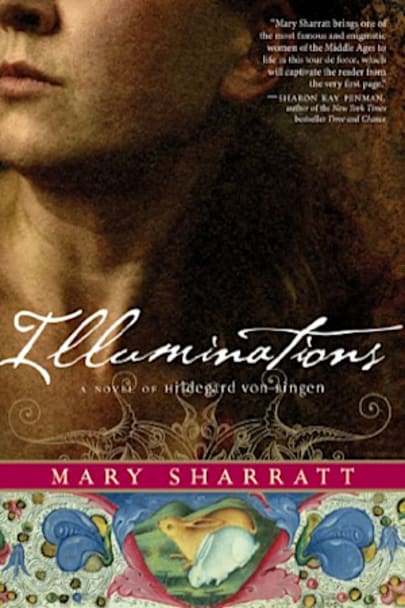From the author of Ecstasty, a novel of a girl who triumphed against impossible odds to become the most extraordinary woman of the Middle Ages.
Hildegard von Bingen—Benedictine abbess, healer, composer, saint—experienced mystic visions from a very young age. Offered by her noble family to the Church at the age of eight, she lived for years in forced silence. But through the study of books and … the study of books and herbs, through music and the kinship of her sisters, Hildegard found her way from a life of submission to a calling that celebrated the divine glories all around us. In this brilliantly researched and insightful novel, Mary Sharratt offers a deeply moving portrait of a woman willing to risk everything for what she believed, a triumphant exploration of the life she might well have lived.
“Sharratt brings one of the most famous and enigmatic women of the Middle Ages to vibrant life in this tour de force, which will captivate the reader from the very first page.” —Sharon Kay Penman, New York Times–bestselling author of The Land Beyond the Sea
“One could not anticipate this majesty and drama…Illuminations is riveting, following von Bingen through…to emerge as one of the significant voices of the 12th century…Unforgettable.” —January Magazine
“Gripping…Like Ann Patchett’s Bel Canto, [Illuminations] is primarily about relationships forged under pressure.”—Publishers Weekly
“Masterful.”—Saint Paul Pioneer Press
more



Mary Sharratt is such a talented author. I first “met” her between the pages of a book when I read THE VANISHING POINT, a poignant portrayal of an unwanted English girl sent to marry someone suitable in the 17th century American colonies, and of the sister who followed her.
This was followed by DAUGHTERS OF THE WITCHES HILL, a sensitive portrayal of the various people put to death in 1612, during the Pendle Witches Trial.
And now we have ILLUMINATIONS, a fictionalized biography of Hildegard von Bingen (1098-1179), the musician, poet and mystic, known during her lifetime as “The Sybil of the Rhine”.
Ms. Sharratt opens her tale when Hildegard is 8 years old, and is walled up in a cell as companion to 14-year-old Jutta who has taken vows an an anchorite. She spends the next 30 years imprisoned in this cell, only being let out after Jutta’s death.
A potential reader might now be wondering if this book is interesting. How can 30 years of boredom and suffocation in a cell be interesting to read about?
But it is.
It is fascinating, and this is what makes Mary Sharratt such a terrific author. In this book, she has outdone herself (and her other novels are very good).
If you have never read Mary’s novels before, or you want to know more about Hildegard von Bingen, BUY THIS BOOK! You won’t be sorry. Five stars. #marysharratt #illuminations
Young Hildegard was the tenth child of an aristocratic family. While her father and two oldest brothers are away fighting in the Crusades for literally decades, Hildegard’s mother starts arranging marriages for her daughters. Hildegard has had strange visions all her life so her mom decides that she will be the family’s gift to the Church. She arranges for Hildegard to accompany Jutta, a higher-ranking noble who wants to become an anchorite at the monastery at Disibodenberg in Germany. Hildegard is only eight years old and doesn’t understand exactly what her future holds.
When the two girls arrive at the monastery, the monks hold a service for the dead to symbolize their passage from the world of the flesh and wall them into two tiny cells that they share. One of the rooms is a courtyard open to the sky and the other has a screen for food to pass through and for conversation. But the girls are never allowed to leave and are expected to live a life of religious prayer and contemplation. Hildegard has always loved the woods and the outdoors and she’s desperate to find a way out. She does feel called to serve God but she knows this is not her path.
I first became interested in Hildegard von Bingen (St. Hildegard) when author Clemency Burton-Hill mentioned her as a composer in Year of Wonder. Ms. Burton-Hill included a brief biography but I was curious to know more. I was thrilled to find this work of historical fiction, although I did wonder how much was history and how much was fiction. The author addresses that at the end. The essential facts are all correct although there is some discrepancy among the source material regarding the age when Hildegard entered the monastery.
The Hildegard in these pages was fascinating. She was a strategist but she also had a heart to care for others. She was “only” a woman but she was a woman with connections and she wasn’t afraid to use them. As she grew older, she called out hypocrisy and inhumane practices. God was always female in her visions. She was an avid learner and read through any books the monks would give her. She trained to be a healer and she became a composer whose work is still fairly widely performed. The breadth of her accomplishments would be remarkable even today; they were almost unfathomable in the twelfth century.
The novel is on the shorter side, at 294 pages in my e-book. I wish the author had spent a bit more time on the final years of Hildegard’s life. The bulk of the story is devoted to her time as an anchorite but I would have liked to read more about her time in the wider world.
If you’re curious, the book is only “religious” in the sense that the author based it on a religious figure. I certainly didn’t feel that there was any sort of Christian agenda.
I highly recommend this if you’re interested in historical fiction about extraordinary women.